Xpo Tool Leaf Blower Vacuum & Shredder 61955 User Guide
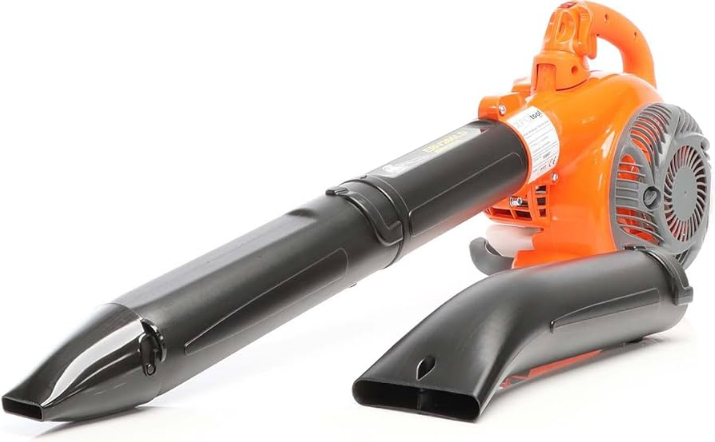
Content
Introduction
The XPO Tool Leaf Blower Vacuum & Shredder 61955 is a versatile gardening tool designed to simplify lawn care tasks. Capable of functioning as a blower, vacuum, and shredder, this multi-functional device efficiently handles various types of debris. Powered by a robust motor, it features a 45-liter collection bag and a 10:1 mulching ratio, reducing the need for manual cleanup. Priced at $199.00, this handheld tool includes a 10-meter cable and a secure harness for added convenience, making it an excellent addition to any gardener’s arsenal. Its variable speed control ensures flexibility in handling different sizes of debris, from leaves to branches.
To minimise the risk of injury we urge that our clients take some basic safety precautions when using this device. Please read the operation instruc-tions carefully and make sure you have understood its content. Keep these operation instructions safe.
Main components
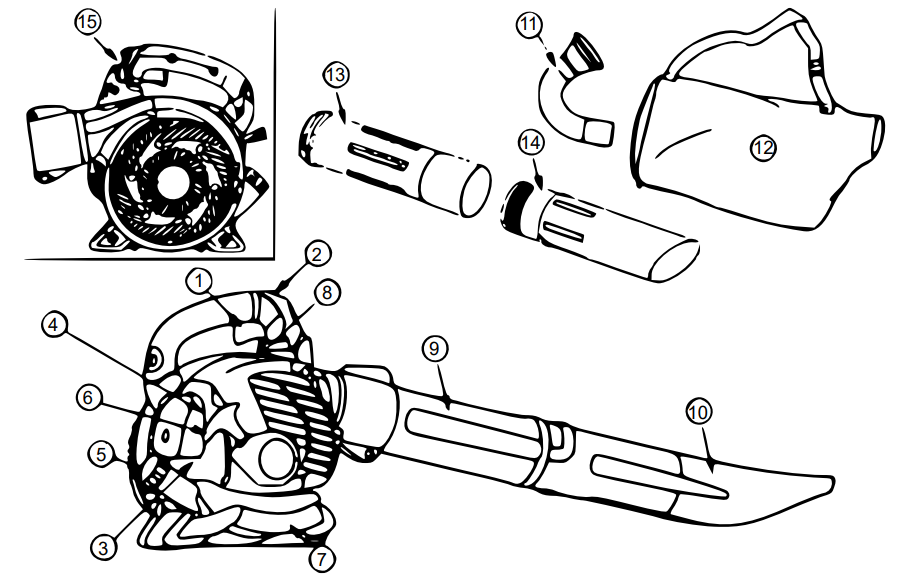
| № | Name | № | Name |
| 1 | Throttle lever | 9 | Upper blowpipe |
| 2 | Stop switch | 10 | Lower blowpipe |
| 3 | Primer | 11 | Connection pipe |
| 4 | Start lever | 12 | Collection bag |
| 5 | Fuel tank cap | 13 | Upper suction tube |
| 6 | Starter rope | 14 | Lower suction tube |
| 7 | Suction tube handle | 15 | Throttle flap lever |
| 8 | Spark plug |
Technical specifications
| Engine type | Air-cooled two-stroke engine (1E34FF) |
| Carburettor type | Diaphragm |
| Displacement (㎤) | 26 |
| Engine power (kW) | 0.8 |
| Idle speed (r⁄min) | 2800 ± 200 |
| Max. speed (r⁄min) | 7500 |
| Speed limit | None |
| Petrol-oil mixing ratio | 1:40 |
| Tank volume (ℓ) | 0.5 |
| Collection bag volume (ℓ) | 50 |
| Average air volume (㎥) | 0.17 |
| Weight (㎏) | 5.8 |
| Total dimensions (㎜) | 580 × 290 × 390 |
Do not operate the machine for a longer period (e.g., more than half an hour) to prevent damage from noise and vibrations. Use a slow speed as little as possible.
Description
Xpo Tool Leaf Blower Vacuum & Shredder 61955 is sleek and ergonomic, making it easy to use for long durations. The device's robust 13-amp electric motor performs well in all settings. The variable speed control lets users modify airflow for blowing leaves, vacuuming garbage, or shredding leaves into fine mulch. The metal impeller in vacuum mode efficiently collects and shreds leaves.
The 1.5-bushel collecting bag reduces frequent emptying. The 50-foot cable lets users cover big areas without chord replacements.
Assembly
Delivery content
The following parts are included:
- Blower
- Upper blowpipe
- Lower blowpipe
- High-speed air nozzle
- Connection pipe
- Collection bag
- Upper suction tube
- Lower suction tube
- Screw for mounting the suction tubes
Note: It is normal for the fuel filter to rattle when the fuel tank is empty.
Warning!
- Stop the engine and ensure that the blower fan blades have stopped rotating before opening the suction port cover or removing the suction tubes or blower tube. The rotating blades can cause serious injury. The spark plug must be removed before servicing the device.
- If the device has been delivered already assembled, repeat all steps to ensure that your device is properly assembled and that all fastenings are tight.
- A screwdriver is required for assembly.
Assembling the blower pipe
Align the guide on the upper blow tube with the notch on the blower outlet and slide the tube in.
Note: The screw of the clamp for the pipe must be so loose that the blowpipes can be inserted into the blower outlet. Loosen the screw by turning it counter clockwise (do not remove the screw nuts).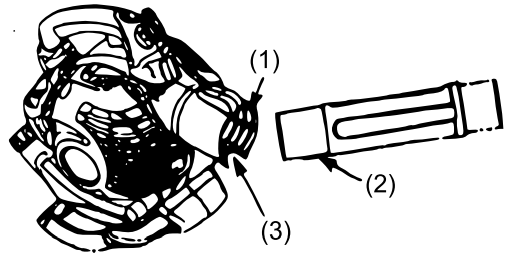
№ Name № Name 1 Blower outlet 3 Rabbet 2 Adjusting spring - Secure the pipes by tightening the screw clockwise.
Align the slots on the lower blowpipe with the tabs on the upper blowpipe.
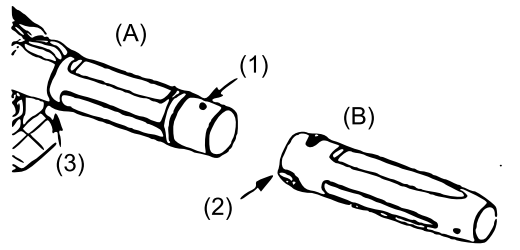
№ Name Letter Name 1 Flap A Upper blowpipe 2 Notch B Lowe blowpiper 3 Clamp screw and rabbet - Slide the lower blowpipe over the upper blowpipe.
- Rotate the lower blowpipe clockwise until a click indicates that the lower blowpipe is snapped and secured onto the upper blowpipe.
- To dismantle the pipes, turn the screw counter-clockwise (do not remove the screw nuts); loosen the pipes and remove them.
Note: The lower and upper blower tubes are correctly installed when the arrows on both tubes are exactly aligned.
Assembling the high-speed air nozzle
Attach the high-speed air nozzle if higher airflow speed is desired.
Align the slots on the nozzle with the tabs on the lower blowpipe.
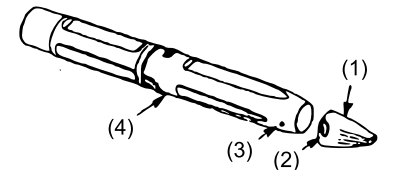
№ Name № Name 1 High-speed nozzle 3 Flap 2 Notch 4 Lower blowpipe - Slide the nozzle onto the lower blowpipe.
- Turn the nozzle to the right until it clicks firmly into place on the lower blowpipe.
- Each section of the pipe was then secured with a screw.
Assembling the collection bag
- Unzip the collection bag and insert the connecting pipe.
Push the narrow end of the connecting tube through the small opening in the collection bag.
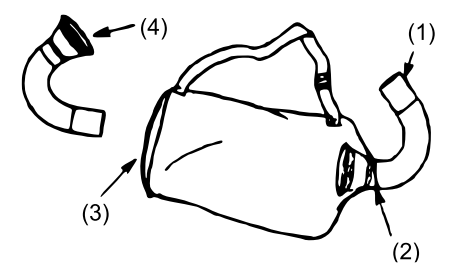
№ Name № Name 1 Adjusting spring 3 Zipper 2 Narrow opening 4 Connection tube Note: Make sure that the edge of the narrow opening is flush with the widening connecting tube and that the notch on the connecting tube points downwards.
- Close the zipper on the collection bag. The zipper must be completely closed.
- Remove the blower tube from the device.
- Push the connecting pipe into the fan outlet. Make sure that the notch in the connecting pipe is on the same line as the guide for the fan outlet.
Turn the knob clockwise to secure the tube.

| № | Name | № | Name |
| 1 | Adjusting spring | 2 | Notch |
Assembling the suction pipe
Warning: Stop the engine and ensure that the blower fan blades have stopped rotating before opening the suction port cover or removing the suction tubes or blower tube. The rotating blades can cause serious injury.
Open the suction opening with a screwdriver. Keep the suction port lid open until the suction tube is installed.

№ Name № Name 1 Cover of the suction opening 2 Suction opening Slide the lower suction tube into the upper suction tube until the lower tube is firmly seated in the upper tube.
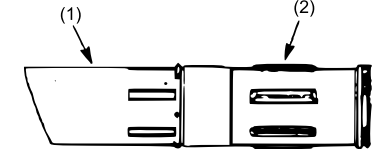
№ Name № Name 1 Lower blowpipe 2 Upper blowpipe Align the tabs on the inside of the suction port with the slots on the suction tube.
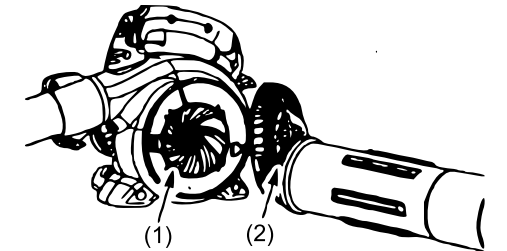
№ Name № Name 1 Flap 2 Notch Push the upper suction tube into the suction opening. Rotate the tube to the right until it clicks securely into place on the suction cup and is firmly seated.
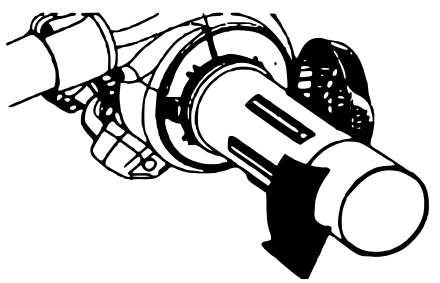
- Arrange the bevelled end of the suction tube as shown. Push the lower into the upper suction tube until the lower suction tube is firmly seated in the upper suction tube (approx. 7 cm). After pushing the two suction tubes together, position the marking on the lower part of the upper tube. Screw the two tubes together using the screw provided.
Warning: Before starting the engine, both the lower and upper vacuum tubes must be installed and each section of the tube be screwed in place.
Converting from leaf vacuum to leaf blower
- Loosen the connecting pipe by turning the knob to the left and remove the connecting pipe and the collection bag.
- Turn the suction tubes clockwise and pull them off.
- Close the lid of the suction opening; make sure the lid is locked into the tab.
- Assemble the blowpipes again (see section “Assembling the blower pipe”).
Adjusting the shoulder strap
- When vacuuming or blowing, always hold the device so that the exhaust pipe is kept away from your body and clothing.
- Place the shoulder strap over your head on your right shoulder.
- Grasp the back of the collection bag with your left arm.
- Adjust the shoulder strap so that the bag/shoulder strap seam lies between the thumb and fore-finger.
- Make sure that the shoulder strap is adjusted to allow unobstructed airflow out of the connecting tube. If the collection bag is bent, the device will not work properly.
Operation
Operating position
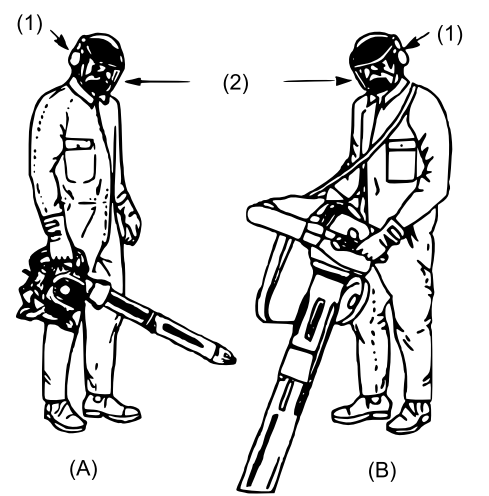
| № | Name | Letter | Name |
| 1 | Hearing protection | A | Leaf blower |
| 2 | Face protection | B | Leaf vacuum |
Operating instructions
- When vacuuming or blowing, always operate the device so that the exhaust pipe is kept away from your body and clothing (see “operating position”).
- To reduce the risk of hearing damage due to high noise levels, wear hearing protection.
- To reduce the risk of injury from touching moving parts, stop the engine before installing or removing accessories. Do not operate the device without protective devices.
- perate the device at appropriate times of the day – neither too early in the morning nor too late in the evening – to avoid disturbing neighbours and other residents. Refer to the times listed in local ordinances. Working hours between 9 a.m. and 5 p.m. from Monday to Saturday are usu-ally advisable.
- To reduce the noise level, operate the device at the lowest possible throttle speed to get the job done.
- Use rakes and brooms to clear the leaves/debris before using the blower.
- Slightly wet a very dusty surface or use a humidifier if water is available.
- Save water by using powered blowers instead of water hoses for your lawn and gardening work. Also suitable for rain gutters, fly nets, patios, grills, verandas, and gardens. Watch out for chil-dren, pets, open windows, and freshly cleaned cars when operating. Safely remove leaves/de-bris.
- Use the entire nozzle extension so that the airflow is directed close to the ground.
- Tidy up after using the device. Dispose of leaves/rubbish in rubbish bins.
- You can use the leaf vacuum function to vacuum up dry waste such as leaves, grass, small twigs, or bits of paper. You can achieve the optimum suction power at a high speed. Slowly move the suction tube back and forth over the material to be removed during the suction pro-cess. Do not insert the suction tube directly into a pile as this could clog the device. The suction tube should be moved back and forth approx. 2–3 cm from the ground for optimal suction per-formance.
Before starting
Warning: Before you start working, it is essential that you read the safety instructions for handling fuel. If you do not understand the safety information, you should not refuel your device. Contact a specialist.

Refueling the device
- Carefully remove the fuel filler cap to add fuel. This engine is approved for operation with unleaded petrol. Before operation, petrol must be mixed with a high-quality air-cooled 2-cycle engine oil. We recommend 2-stroke oil mixed in a ratio of 1:40.
- When mixing fuel, follow the directions on the container. Always read and follow the safety precautions before refuelling your device.
Important: Alcohol-based fuels (gasohol or mixtures of ethanol or methanol) can attract moisture. This breaks down the fuel mixture and acids can form during storage. Acidic gases can damage the fuel system of the device during storage. - To avoid device problems, empty the tank if you are not going to use the device for more than 30 days. Empty the fuel tank, start the engine, and run it until the fuel lines and carburettor are empty. Use new fuel the next time you use it.
- Never add engine or carburettor cleaners to the fuel tank. Your device could be permanently damaged. Alternatively, fuel stabilisers can be used during storage to reduce gum build-up.
Stopping the device
- Release the throttle.
- Press the stop switch to the stop position until the engine stops.
Before starting the engine
Warning: Before starting the device, make sure that the pipes are properly fastened.
- Refuel the device. Stand at least 3 m from the refuelling point.
- Hold the device in the starting position as shown. Hold the device so that the blower/suction pipe is not pointed at people, animals, glass, or other solid objects.
| Starting position | |||
| Letter | Name | Letter | Name |
| A | Leaf blower | B | Leaf vacuum |
Warning: Hold the device as shown when starting. Only place the device on a clean, firm surface to start it up or during operation. Debris such as gravel, sand, dust, grass, etc. could be caught by the suction opening and thrown out through the air outlet which can lead to damage to the device and property as well as serious injuries to the user and people around.
Starting a cold engine
- Move the throttle lever (1) to the idle position.
- Slowly push the primer pump six times.
Set the start lever to the “Start” position.
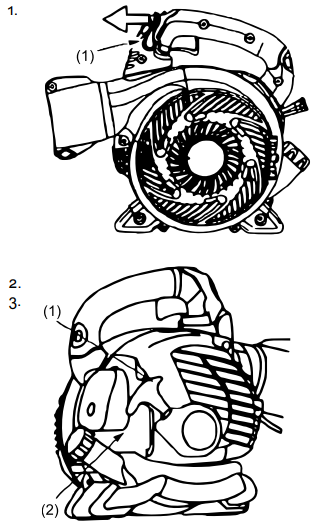
- Pull the starter handle vigorously, in a controlled manner, and evenly 6 times (at temperatures above 32 ℃ no more than 3 times!). If the engine starts before pulling the starter handle 5 times, run the engine for 5 s. Then push the throttle lever completely to deactivate the start system (the start lever returns to the “run” position). Step 5 is then not required.
- Pull firmly on the starter handle while squeezing the throttle until the engine starts and runs.
Starting a warm engine
- Press and hold the throttle lever.
- Pull firmly on the starter handle while pushing the throttle lever until the engine starts and runs.
Note: Normally, the warm start can be still carried out approx. 5–10 minutes after the device has been switched off. After a downtime of more than 10 min, start the device after cold start procedure or follow the start instructions printed on the unit.
Starting a stalled engine
Engines can be started by moving the start lever to the “run” position and pressing the throttle fully. Pull the starter lever repeatedly while depressing the throttle until the engine starts and runs. This may require pulling the starter handle several times, depending on how heavily the device is stalled. If the device still does not start, refer to the troubleshooting section.
Setup Guide
Steps to install and use the xpo Tool Leaf Blower Vacuum & Shredder 61955.
- Unpack the gadget and accessories.
- Snap the blower tube and nozzle together.
- Plug the vacuum inlet with the collecting bag.
- Plug the gadget and secure the cable.
- Choose blower, vacuum, or shredder mode with the mode selector switch.
- Use the variable speed control to adjust speed.
Maintenance
Warning!
- Never touch the exhaust system unless the engine and exhaust are cold. Touching a hot ex-haust can result in serious burns.
- The spark plug must be removed before maintenance work. This is not necessary for carburettor adjustments.
Checking for loose fastenings and parts
- Exhaust
- Spark plug gasket
- Air filter
- Housing screws
Checking for damaged or worn parts
Contact an authorised service dealer for replacement of damaged and/or worn parts.
- Fuel tank: Never operate the device with a damaged or leaking fuel tank
- Collection bag: Never operate the device with a damaged or torn collection bag.
Check and clean the device and labels
- Check the device for loose or damaged parts after each use. Clean the device and badges with a damp cloth and mild detergent.
- Dry the device with a clean, dry cloth.
Cleaning the air filter

| № | Name | № | Name |
| 1 | Air filter | 2 | Air filter cover |
A dirty air filter will affect performance of the engine and increase fuel consumption and emissions. Clean the air filter after every 5 hours of operation.
- Clean the cover and areas around it to prevent debris from entering the carburettor when you remove the cover.
Note: Before opening the air filter cover, move the choke lever to the “run” position. - Remove the parts as shown.
Note: Do not clean the filter with petrol or other flammable solvents. This can create a fire hazard or harmful evaporative emissions. - Clean the filter with soap and water.
- Let the filter dry.
- Apply a few drops of oil to the filter; squeeze the filter to distribute the oil.
- Reinstall the parts.
Replacement of spark plugs
Replace the spark plugs annually for easier engine starting and efficient operation. Set the electrode gap to 0.0635 cm (0.025 in.). The ignition timing is fixed, i.e., it cannot be changed.
- Turn, then pull out the spark plug boot.
- Remove the spark plug from the cylinder and discard it.
- Replace the spark plug with an RCJ-6Y type spark plug. Fasten it with a 19 mm socket wrench.
- Reinstall the spark plug boot.
Replacing the fuel filter
To replace the fuel filter, first allow the device to idle until all fuel is used up. Then remove the tank cap with the holding device from the tank. Pull the filter off the tank and disconnect it from the fuel line. Place the new fuel filter in the fuel line and reassemble the remaining parts.

| № | Name | № | Name |
| 1 | Fuel filter | 2 | Fuel line |
Checking the exhaust retaining screws
Once a year, check that the exhaust retaining screws (1) are securely tightened to prevent damage.

Adjusting the carburettor
The carburettor was precisely adjusted in the factory. An adjustment of the idle speed may be necessary under the following conditions. The engine does not go into idle when the hand throttle is released.
Adjusting the idle
Let the device idle. Adjust the idle speed so that the machine runs without stopping (idle speed too low).
- Turn the idle speed screw clockwise to increase the engine speed if the engine stops or dies.
- Turn the idle speed screw counter-clockwise to decrease the engine speed.

| № | Name | № | Name |
| 1 | Idle regulator | 2 | Air filter cover |
XPO Tool Leaf Blower Vacuum & Shredder 61955 Storage
Storage location
Attention: Prepare your device for storage at the end of the season or if you will not need it for more than 30 days.
- Allow the engine to cool and secure the device before storing or transporting it.
- Store and fuel the device in a well-ventilated place safe from flying sparks and open flames from devices such as water heaters, electric motors, switches, stoves, etc.
- Store the device with all protective devices. Put the device down so that nobody can accidentally injure themselves on sharp parts of the device.
- Keep the device and fuel out of the reach of children.
Exterior
- Clean your device carefully before storing it for a long period of time. Keep the device in a clean, dry place.
- The outer metal surfaces should be lightly oiled.
Interior
- Remove the spark plugs and pour a teaspoon of 2-stroke (air-cooled) engine oil into the spark plug opening. Slowly pull the starter cord eight to ten times to distribute the oil.
- Replace the spark plug with a plug of the appropriate type and heat rating.
- Clean the air filter.
- Check the entire device for loose screws, nuts, and bolts.
- Replace any damaged, brittle, or worn parts of the device.
- Always start the new season with fresh fuel in the correct petrol-oil ratio.
Others
- Do not store fuel for the next season.
- Replace your fuel canister as soon as it starts to rust.
| Wrong carburettor mixture | Have the carburettor adjusted by an authorised service | |
| The engine will not start. | Wrong carburettor mixture | Have carburettor adjusted by au- thorised service, |
| Clogged air filter | Clean or replace air filter. | |
| No power supply under load | Old or incorrectly mixed fuel | Empty fuel tank and fill it with fresh fuel. |
| Wrong carburettor mixture | Have carburettor adjusted by au- thorised service. | |
| Clogged air filter | Clean or replace air filter. | |
| Runs irregularly | Dirty spark plug | Clean or replace spark plug. |
| Incorrectly adjusted spark plug | Clean gap or replace spark plug. | |
| Clogged spark protection | Clean or replace spark protector. | |
| Engine smokes excessively | Dirty air filter | Clean or replace air filter. |
| Wrong carburettor mixture | Have carburettor adjusted by au- thorised service. | |
| Incorrect fuel mix ratio | Use properly mixed fuel. | |
| Choke lever in half position | Vary position of choke lever. |
Safety instructions
Warning: Failure to follow all safety rules and precautions could result in serious injury.
Familiarize yourself with the device
- Read the operating instructions carefully until you have fully understood and are able to follow all warnings and safety advice before you start using the device.
- Limit the use of the device to users who understand and will follow all warnings and safety instructions in this manual.
Safety within working area
- Remove debris or grass clippings from driveways, pavements, patios, etc.
- Blow the clippings, straw, and leaves in a pile.
Warning: Examine the work area before starting the device. Remove all debris and hard objects such as rocks, glass, wire, etc. that could ricochet, be thrown, causing injury or damage during operation.
Personal safety
- Warning: This machine generates an electromagnetic field when in operation. This field can affect the functioning of active or passive medical implants under certain conditions. To avoid the risk of serious injury or death, persons with a medical implant should consult their doctor and/or the manufacturer of the implant before using this machine.
- Always wear protective glasses and ear protection when using and maintaining the device. Stirred stones or debris could otherwise be thrown in your eyes or face and lead to serious injuries and/or blindness.
- Always wear safety shoes. Never use the device barefoot or wearing sandals.
- Always wear a dust or face mask when working in a dusty environment.
- Tie hair together that exceeds shoulder length. Secure or remove any jewellery, loose clothing, loose straps, ribbons, fringes, etc., as they could be caught by moving parts.
- Never work with the leaf blower if you are tired or feel ill, or if you are under the influence of alcohol, drugs, or medicine.
- Keep children, animals, and other bystanders at least 15 m from your work area when you start or use the device. Never point the air nozzle at other people or animals.
Fuel-handling safety
- Eliminate all sources of sparks or flames (including jobs that may cause sparks) and do not smoke in areas where fuel is mixed, poured, or stored.
- Mix and pour fuel in an outdoor area. Store fuel in a cool, dry, well-ventilated place. Use an approved, labelled container for all fuel purposes.
- Do not smoke when handling fuel or operating the device.
- Make sure that the device is properly installed and in good working condition.
- Do not fill the fuel tank when the engine is hot or running.
- Avoid spilling fuel or oil. Wipe up any fuel spills before starting the engine.
- Before starting the engine, move at least 3 m from the fuel and the refuelling point.
- Always store fuel in a container approved for flammable liquids.
Safety of operation
- Warning: Stop the engine before opening the vacuum opening cover. To avoid injury, the en-gine must be switched off and the blades of the blower fan must no longer rotate.
- This leaf blower/vacuum cleaner is only suitable for blowing together and vacuuming leaves and other debris on the ground.
- Before each use, inspect the device for worn, loose, missing, or damaged parts. Only operate the leaf blower when it is in perfect condition.
- Always remove oil and fuel from the housing. Never start the device in closed rooms or build-ings. Inhaling exhaust gases can be fatal!
- Exhaust systems can get very hot and will remain so for some time after stopping. This also applies to idle use. Contact can cause burns to the skin. Think about the fire hazard!
- To avoid static electric shock, do not wear rubber gloves or other insulated gloves during oper-ation.
- Do not place the device on any surface other than a clean, hard area while the engine is running. Foreign objects such as gravel, sand, dust, grass, etc. can be picked up by the air inlet and ejected through the exhaust opening, which can damage the device or property, or cause seri-ous injury to bystanders or the user.
- Avoid dangerous environments. Do not work in unventilated rooms or in places where explosive gases or carbon monoxide can develop.
- Do not work on unstable surfaces such as ladders, trees, steep slopes, roofs, etc. Make sure that you keep balance and always stand securely.
- Do not insert any objects directly into the suction tube. Always hold the device so that the suction material discharged is not directed at people, animals, glass, or solid objects such as trees, cars, walls, etc. The air discharge pressure can throw up stones, dirt, or sticks and thereby injure people and animals, break glass, or cause other damage.
- Only operate the device with the suitable accessories. Always mount the blowpipes for use in blowing operations. The suction pipes and collecting bag must be installed for suction operation. Make sure that the collection bag is completely closed.
- The suction opening, blowing or suction pipes, and connecting pipe must be checked regularly. The engine must be switched off and the spark plug connector removed. Keep vents and ex-haust pipes free of debris to ensure proper airflow.
- Never insert objects into the suction opening. Doing so could obstruct airflow and damage the device.
- Never use the device to spray chemicals, fertilisers, or other substances that may contain toxic substances.
- To prevent fire spreading, do not use the device near burning branches or bushes, chimneys, barbecue areas, ashtrays, etc.
- Use the device only for the tasks described in this manual.
Safety of maintenance
- Any maintenance work not listed in this manual should be performed by a qualified person.
- The spark plug cap must be removed before servicing the device. This is not necessary for carburettor adjustments.
- Use only recommended spare parts. The use of other spare parts can invalidate your warranty and damage your device.
- Empty the fuel tank if the device is not used for a long time. Use the remaining fuel in the carburettor by starting the engine and running it until it stops by itself.
- Do not store the device or fuel in a closed area where fuel exhaust gases can come into contact with sparks, open flames (e.g., from water heaters), electric motors or switches, stoves, etc.
- Store the device in a dry place out of the reach of children.
- Secure the device during transport so that it cannot skid, tip over, or fall.
Note!
With people having circulatory disorders, prolonged use of petrol-powered devices can damage blood vessels and nerves in fingers, hands, and joints due to vibrations. Long-term use in cold weather can damage the blood vessels even in healthy people. Stop using the device and seek medical help imme-diately if you notice any of the following symptoms: numbness, pain, weakness, changes in skin colour or texture, numbness in your fingers, hands, or joints. Having an anti-vibration system does not mean that these symptoms cannot occur at all. People who often use privately or work professionally with petrol-powered devices should always keep an eye on their health and the condition of the device.
Warning!
The device cannot be used to vacuum leaves with twigs or branches. Otherwise, this machine may be blocked. If a blockage occurs, tap the machine casing lightly to loosen it. Never dismantle the suction line. If that does not work, contact your vendor.
Troubleshooting
Warning: The spark plug must be removed before servicing, except for carburettor adjustments.
| Problem | Possible causes | Remedy |
| The device will not start or starts, but does not run. | Wrong starting procedure | Follow instructions in this man- ual. |
| Wrong carburettor mixture | Have carburettor adjusted by au- thorised service. | |
| Dirty spark plug | Clean gap or replace spark plug. | |
| Empty fuel tank | Fill fuel tank with properly mixed fuel. | |
| The device starts, but the engine lacks power. | Fuel filter clogged up | Replace spark arrestor. |
| Wrong lever position | Move lever into “run” position. | |
| Dirty spark protector | Replace spark protector. | |
| Dirty air filter | Remove, clean and reinsert the filter |
Pros & Cons
Pros
- Multipurpose design saves space and money.
- Powerful 13-amp motor for reliability.
- Airflow adjusted by speed.
- Huge 1.5-bushel bag simplifies emptying.
- Comfortable ergonomic design.
Cons
- Strong construction makes it heavier than other versions.
- Long cords may be inconvenient if not controlled.
- No battery; power source required.
Customer Reviews
Customers love the XPO Tool Leaf Blower Vacuum & Shredder 61955 flexibility and power. It simplifies and speeds up yard labor, according to many. Some consumers have complained that the gadget is heavier than expected and that the lengthy cord is difficult to manage.
Complaints Most Common
- Weight of gadget.
- Cord management difficulties.
Faqs
How do I switch between blower, vacuum, and shredder modes?
What is the shredder ratio of the xpo Tool Leaf Blower?
Is the xpo Tool Leaf Blower suitable for large yards?
How often should I clean the air filter?
Can I use this device in wet conditions?
What safety precautions should I take while operating this device?
How do I store the Vacuum & Shredder when not in use?
Is there a warranty on this product?
Can I purchase replacement parts for this device?
Is this device energy-efficient?
Leave a Comment
